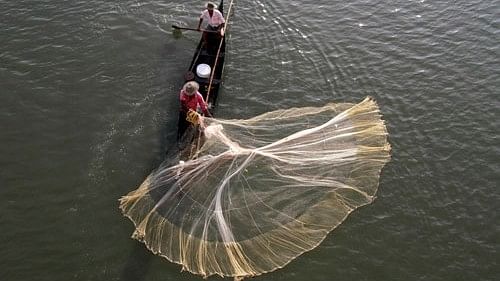
Representative image of Gujarat coast near Jakhau port.
Credit: Reuters file photo
Ahmedabad: Gujarat, with the longest coastline of 1,600-km in the country, is deeply rooted in the bounty of its waters, producing an annual average of 8.5 lakh tonnes marine fish in the last four years.
The state, which has also contributed to 17 per cent of India's total fish exports at Rs 5,000 crore, is now urging its traditional fishing community to adopt modern technologies to harvest the potential of deep-sea fishing, which provides immense possibilities of growth.
The 10th edition of Vibrant Gujarat Global Summit, scheduled to be held in state capital Gandhinagar from January 10 to 12, 2024, is likely to give further push to this industry.
The biennial summit serves as a platform for businesses and governments to explore investment opportunities and establish partnerships.
"Gujarat has the longest coastline of about 1,600 km. It is at the forefront of fish production. Today, Gujarat is exporting fish worth more than Rs 5,000 crore, taking the state's contribution to 17 per cent of India's total fish exports," Chief Minister Bhupendra Patel said at an event organised here recently.
"When Prime Minister Narendra Modi was the chief minister of Gujarat, he started the Sagar Khedu Sarvangi Vikas Yojana for the overall development of the fisheries sector, which has been very successful. Today, the blue economy sector of Gujarat is growing very fast," Patel said.
From fishing operations to processing, the industry plays a crucial role in generating employment and contributing to the state's economy, officials and fishing community members said.
Jitu Kahada, a leader of the fishermen community in Gujarat's Gir Somnath district, said the central and state governments have come up with a scheme to provide new gas machines to small traditional fishermen, something that is benefiting them in many ways.
As per the data provided by the state government in July this year, the provisional marine fish production in 2022-23 is likely to be 6,97,151 metric tonnes and the inland fish production at 2,07,078 metric tonnes.
The government said it has undertaken several initiatives to promote the fisheries sector, such as reduction in the VAT rate on diesel, subsidy on kerosene and petrol, improving infrastructure of small fishing ports, and construction of four new fish harbours at Madhwad, Navabandar, Veraval-II and Sutrapada.
The government has also worked to create weather and safety awareness in coastal areas, which has also contributed in improving the fisheries sector.
The efforts of the government have led to a change in the lives of the state's fishing community members.
According to the state government, the average annual income of a fisherfolk family in Gujarat has seen a steady climb from Rs 6.56 lakh to Rs 10.89 lakh in the last five years.
Machine boats by far outstrip the traditional boats, with the former being 28,355 in number compared to 8,625 traditional ones, as per the data provided by the state government.
Now, the focus is also to tap into the potential of deep-sea fishing, with both the central and state governments jointly providing support to traditional fishermen in this transition by helping them acquire deep-sea fishing boats, Union Minister of State for Fisheries, Animal Husbandry and Dairying L Murugan said at the Global Fisheries Conference India 2023 organised here recently.
This support will be extended through the Centre's schemes, namely the Blue Revolution and the Pradhan Mantri Matsya Sampada Yojana, he said.
Under the scheme, the government provides up to 60 per cent financial assistance to traditional fishermen to convert their vessels into deep-sea fishing boats. Additionally, loan facilities are also available to facilitate this transformation, stated an official release.
Deep-sea fishing is undertaken beyond the limit of territorial waters, which is 12 nautical miles from the shore and within the Exclusive Economic Zone (EEZ) of 200 nautical miles from the shore. It involves catching fish that live in deep parts of the sea.
Deputy Commissioner of Fisheries, Government of India, Sanjay Pandey, said the 'Indian Ocean yellowfin tuna', a fish variety, has an end value of more than $4 billion.
According to World Bank consultant Dr Arthur Neiland, despite the promising potential of yellowfin and skipjack tunas in India's EEZ, with an estimated harvest of 1,79,000 tonnes, the actual catch is just 25,259 tonnes, indicating the utilisation rate of only 12 per cent.
He has emphasised the need for investment from public and private sectors in deep-sea fishing which could generate economic, social and environmental benefits.